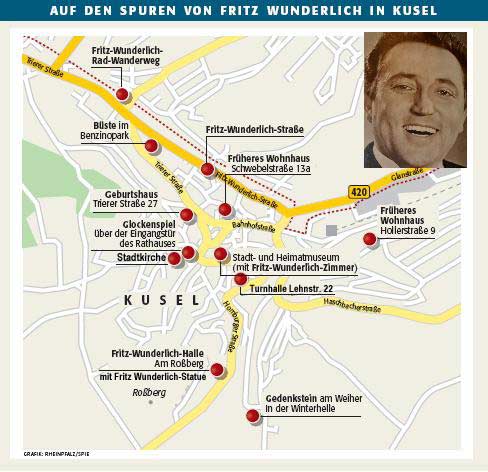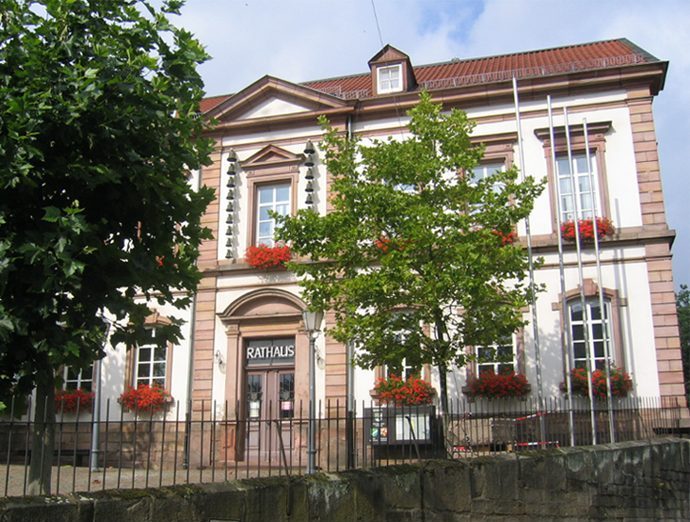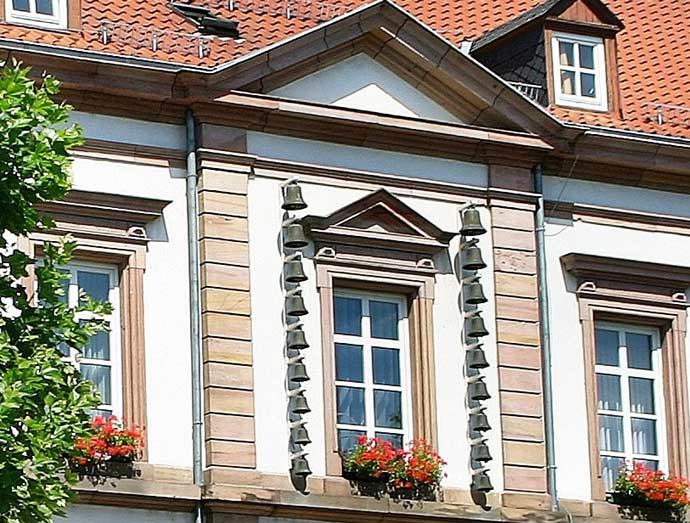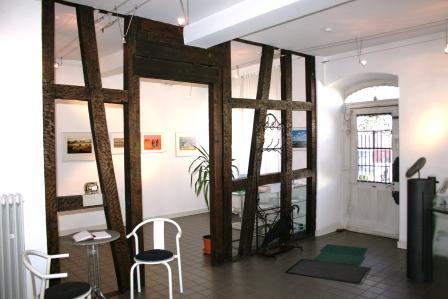
A walk through the town
You can use the arrows to navigate through the slides
The passion for fast cars
The passion for fast cars for example, is one such story. Fritz loved fast cars and motorcycles and he shared this passion with his friend Otto Hermann, who also lived in the „Hollerstraße“. In letters sent from Fritz to Otto, it seemed like a conspiracy between the two. During the years in Stuttgart, Fritz and Otto regularly went to the well-known motorcycle racetrack „Solitude“.
But no one was supposed to know about these meetings, especially not Otto’s family, who had no understanding for this passion. Before these events, Fritz therefore sent Otto letters which contained the train and entrance ticket, the departure times and transfer stations and their meeting point at the racetrack. Precautionally, he also reminded his friend once again to keep everything a secret. Otto then went to Stuttgart, together they watched the race and after that they drove back to Kusel in Fritz’s car.
As a matter of fact, their meetings at the racetrack remained a secret. No one ever had an idea what Fritz and Otto were doing in Stuttgart only until decades later, the letters were discovered in an old shoe box.
The Town Hall
The town hall has a carillon above the main entrance, which is attached on both sides of the middle window. It was installed in1884 and consists of 18 precisely tuned bronze bells, which are automatically switched on and off. They weigh 276,5 kg in total weight and can also be played by hand from a simple keyboard at the town hall. The carillion regularly plays the melody of Fritz Wunderlich’s song „Mein Kusel in der Pfalz“, in which the tenor pays tribute to his hometown. It can be heard every day at 12:20 p.m.
Museum (1)
The Local Town Museum
The local town museum of Kusel is located at the former pharmacy on Marktstraße 27, which belonged to the Michaelis family. It is an old three-story building, built in a classical style. After being destroyed by fire in 1794, the house was rebuilt a few years later. The museum is considered to be one of the most beautiful classical houses in Kusel.
The museum is open from Tuesday to Sunday from 2 p.m. to 5 p.m..Apart from the opening hours guided tours can be offered. To make arrangements please call: +49 6381 8222
Museum (2)
The rooms on the ground floor are used for different exhibitions by professional and hobby artists.
Upstairs, visitors can find pieces from the history of the city. Apart from furniture past times and historical oven plates, the former tower clock of the Protestant church has found its special place in the museum.
There is also a large collection on Fritz Wunderlich and the Fritz Wunderlich Association is based on the first floor. Furthermore, the entire archival marterial, which has been collected by the Association over many years, can also be found at the museum.
The Municipal Church

On the 12th of July 1829 the foundation stone was laid to build the Protestant Church and shortly after, on the 16th of October 1831, the church was inaugurated. The term „municipal church“ is misleading and refers to a time in which only one denomination was predominant. The construction work was done by the „Bell Construction Company“ of Kusel. The steeple is a landmark, overtowering all other buildings in Kusel and fits harmoniously into the historic atmosphere of the old town square.
The following events in the life of the Fritz Wunderlich family took place in the town church.
Baptism
On the 21st of February 1931 Fritz was baptized in the Protestant town church of Kusel by Pastor L.H. Baum. The baptismal records read as follows: Wunderlich Friedrich (Karl) Otto, born on the 26th of September in 1930.
Confirmation
On the 18th of March in 1945 at 6 o’clock in the morning, the confirmation service started with dean Andreas Cassel holding the church service. Shortly after, American fighter-bombers flew across town and the church doors were torn open, due to the pressure of the detonating bombs. Immediately, the dean blessed all the children, the church service was ended and the visitors flew into the nearby air-raid shelters. It was an unusually quick service and Fritz’s confirmation was recorded in the church register: Wunderlich, Friedrich born 26th of September1930, confirmed 18th of March in1945.
Marriage
On the 25th of August 1956 Fritz was married in Stuttgart. The church marriage took place in Kusel with family members, early in the morning on the 5th of September 1956. The church marriage ceremony was held by dean Andreas Cassel, who also had confirmed Fritz. Witness to the marriage was sexton Otto Geminn.The church register reads the following: Wunderlich, Friedrich Karl Otto, tenor at the theatre of Stuttgart, born on the 26th of September in 1930 in Kusel, son of Paul Wunderlich, musician, died in Kusel and Mrs Anna, neé Malz, Kusel. Jungnitsch, Eva-Maria Christa Isolde, Stuttgart, born on the 5th of December in 1934 in Stuttgart, daughter of Fritz Jungnitsch, chamber musician in Stuttgart and Mrs Hedwig, neé Geiger, violonist in Stuttgart.
Baptism
Constanze, the daughter of Fritz Wunderlich was baptized in Kusel on the 1st of May 1958. The baptismal register reads the following: Wunderlich, Constanze Marianne, born on 26th of August in 1957 in Berlin. Cassel, dean.
The Birth House
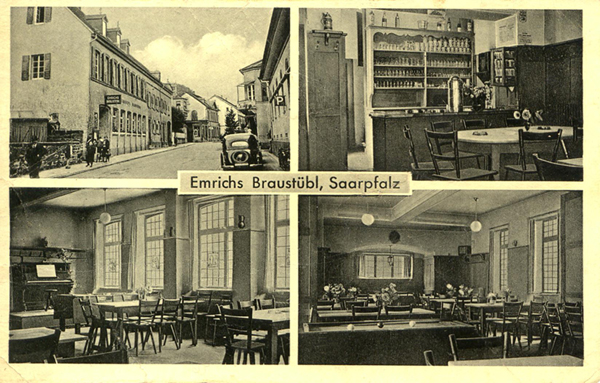
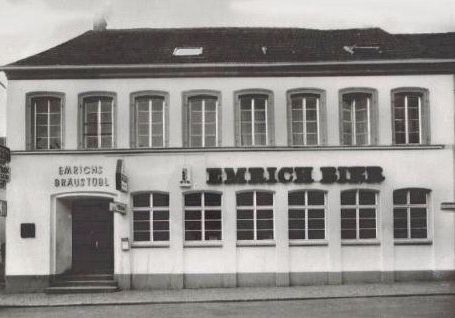
In 1929, band leader Paul Wunderlich, his wife Anna and their 11 year old daughter Marianne moved to Kusel,Trierer Straße 27, where they called the inn „Emrich’s Bräustübl“ with an adjoining cinema and the upstairs apartment their new home.
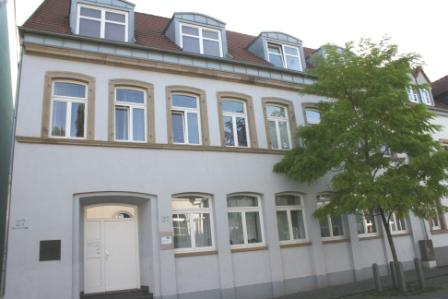
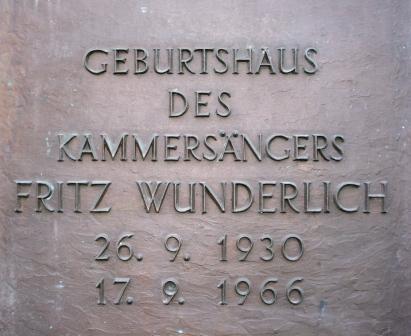
In February 1931, the cinema had to be closed as it did not meet modern standards. Unfortunately, the Wunderlich family could not afford to pay for the necessary renovations due to the ongoing economic crisis. The inn was also less profitable thus, the family was not able to pay the lease anymore. Due to this situation, their debts began to grow. As a result , their furniture were seized shortly after and inevitably, the inn was closed in 1933.
Today the building has been modernized and is used as an apartment and an office building. A bronze plate next to the entrance indicates Fritz Wunderlich’s residence.
The House Schwebelstrasse 13
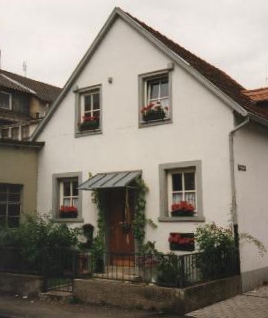
In 1933, the Wunderlich family sold the inn and rent a small house on Schwebel Street No 13 next to the Kuhn’s locksmith shop. Their new home was located not far from Trierer Street and they lived there for three years.
The House Hollerstrasse 9
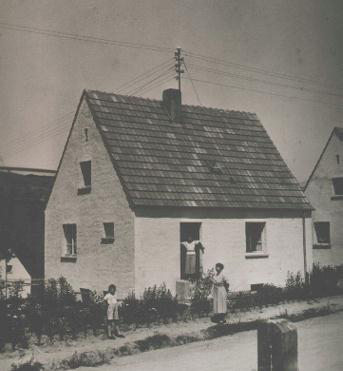
The National Socialist Assistance for War Victims had released the grounds in a part of Kusel called “Holler“ in order to build small houses. The structural work was already completed by the end of 1934. Sixty more houses were built between 1935 and 1936.
War invalids had the preferential right to acquire these houses. Paul Wunderlich was seriously wounded during World War I. He was shot in the stomach and years later, he still had to wear bandages day and night. Even though, he was the one who bought the property, he did not live to see the house be built. He died on the 23rd of October in 1935, leaving his wife to support the family. During these difficult postwar years, this was not an easy task for her.
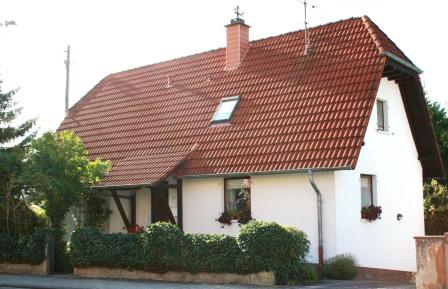
In March 1936 the construction was finished and the family was able to move into their new home on Holler Street No. 9. One year later, Fritz´s sister Marianne got married and moved to her husband so that only Fritz and his mother lived together in their small house.
In the beginning of October in 1950, Fritz successfully took the entrance examination at the state music college in Freiburg. As the semester already started at the end of the months, Fritz quickly had to find a place in Freiburg. Luckily he found a room with a piano in the center of the historic district on Rempart Street No 3. Fritz’s mother stayed alone in her house on Holler Street but Fritz often visited her, until her death on the 29th of October in 1963.
The bust of Fritz Wunderlich in the Benzino Park
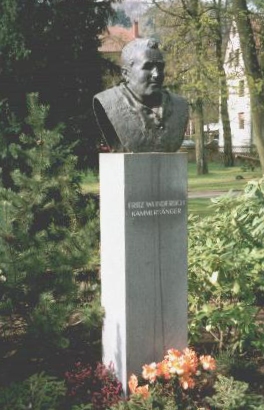
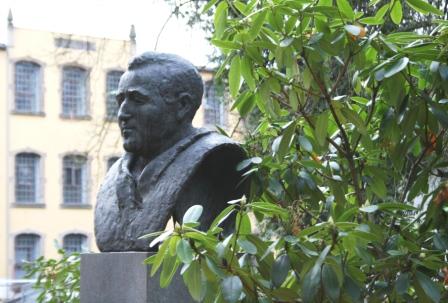
This piece of artwork was made by Professor Erich Koch. He worked on it from October 1972 until February 1973 with short interruptions. He casted the bust out of bronze and used a certain technique with melted wax. Creating the bust represented a challenge, as Fritz Wunderlich did not pose for it . Instead, Professor Koch only worked with photographs of the singer. He tried his best to perpetuate Fritz Wunderlich as a stage artist.
On the 8th of February 1973 he presented his work to the public for the first time together with Eva Wunderlich in Munich.
On the 9th of March 1973, a Saturday morning, the Fritz Wunderlich bust was handed over to the district of Kusel. After being exhibited at the local bank (Kreissparkasse) and at the local historic museum, this piece of art found its final destination at the town park (Benzino Park) on Wednesday the 17th of September 1986 at 19.30.The bust was presented in commemoration of Fritz Wunderlich’s 20th anniverary of his death.
Memorial Stone at the Winterhelle
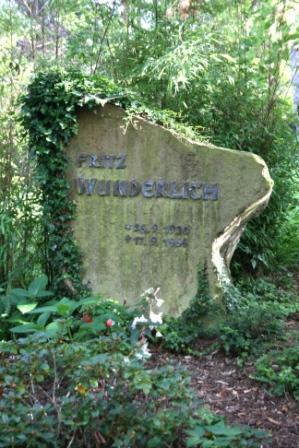
On the 10th day of Fritz Wunderlich’s death, the 17th of September 1976, a memorial stone was unveiled at the entrance of a wooden area on the outskirts of Kusel (Winterhelle). Fritz Wunderlich often went hunting in these woods. The „Verkehrsverein“ Kusel took the initiative to set up this memorial stone and also financed it. The stone originated from the stone quarry in the nearby village, Rammelsbach and shows the name of Fritz Wunderlich and his dates of birth and death in bronze letters.
Fritz Wunderlich Hall

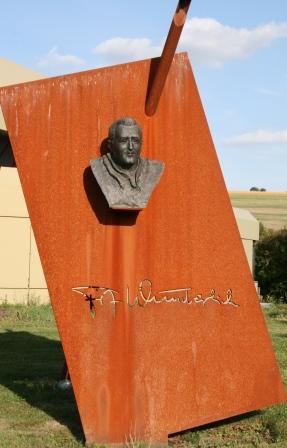
The hall was built next to the school centre on the Roßberg and is used as an autitorium and civic centre. It was inaugurated in 1885. The town of Kusel, the municipality and the district of Kusel jointly worked together on the project and the state Rhineland Palatinate also helped finance it. Former county mayor Kurt Theiß suggested to name the hall after Fritz Wunderlich, and the majority of the people supported this idea.
1988, the hall was given its name – Fritz Wunderlich Hall.
The hall has room for about 600 spectators and is set up in the form of an amphitheatre. In this way the performers can have closer contact with the audience. The stage provides enough space to seat a large orchestra or a large choir. An organ complements the equipment of the hall.
The programme runs from September until June and offers a variety of plays, concerts, operettas, cabaret shows, etc. and a special programme for children and young adults
In the year of 2011 a replica of the Fritz Wunderlich bust by Erich Koch was placed in front of the hall.
You can find the current programme here.
The Wunderlich Trail
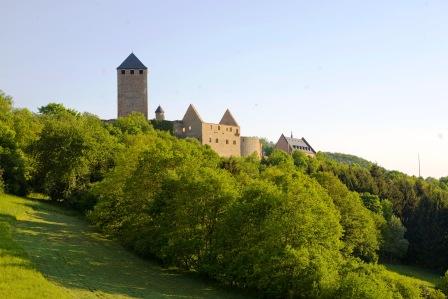

Music is undoubtedly a connecting element between people just like trails connect different parts of the country with each other. And so the name Fritz Wunderlich is a synonym for a biking and hiking trail, which connects the two states Rhineland Palatinate with the Saarland.
The trail begins in Kusel at the street called „Vogelsang“, just behind the building of the AOK (health insurance company). It takes you through the district of „Diedelkopf“ and leads you to Thallichtenberg. Here, it is worth to stop a while and visit the castle ruin Lichtenberg Castle, a landmark of the district Kusel. This impressive castle ruin, which lies upon the hill, was built in the 13th century by the counts of Veldenz.
For more information about the castle click here.
After passing through Pfeffelbach, the trail crosses the Palatinate border and takes you to the Saarland. Arriving in Schwarzerden, you have the opportunity to stop and visit the Temple of Mithras (Mithrastempel). Continuing the route, the trail then passes through an old tunnel and over a bridge towards Freisen. The bridge over the valley is one of the most impressive examples of railway architecture in this region.
The Fritz Wunderlich trail stretches over a length of 21 kilometres and was formerly used as a railway line. Due to the low incline and its good maintenance, the trail is ideal for families, senior citizens and handicapped people.
Trail information:
Length: 21 kilometres
Time to walk: about 6,5 hours
Rise: 397 metres
Incline: 176 metres
Maximum height: 491 metres
Minimal height: 228 metres
Difficulty: moderate
The Fritz-Wunderlich-Street

This ist he main street which runs through Kusel. It starts at the beginning of the Trierer Straße and runs to the beginning of the Glanstraße. This is the federal road (B420). In November 1969 the city council decided to rename the Alte Straße in Fritz Wunderlich Straße in honour of the deceased artist.
